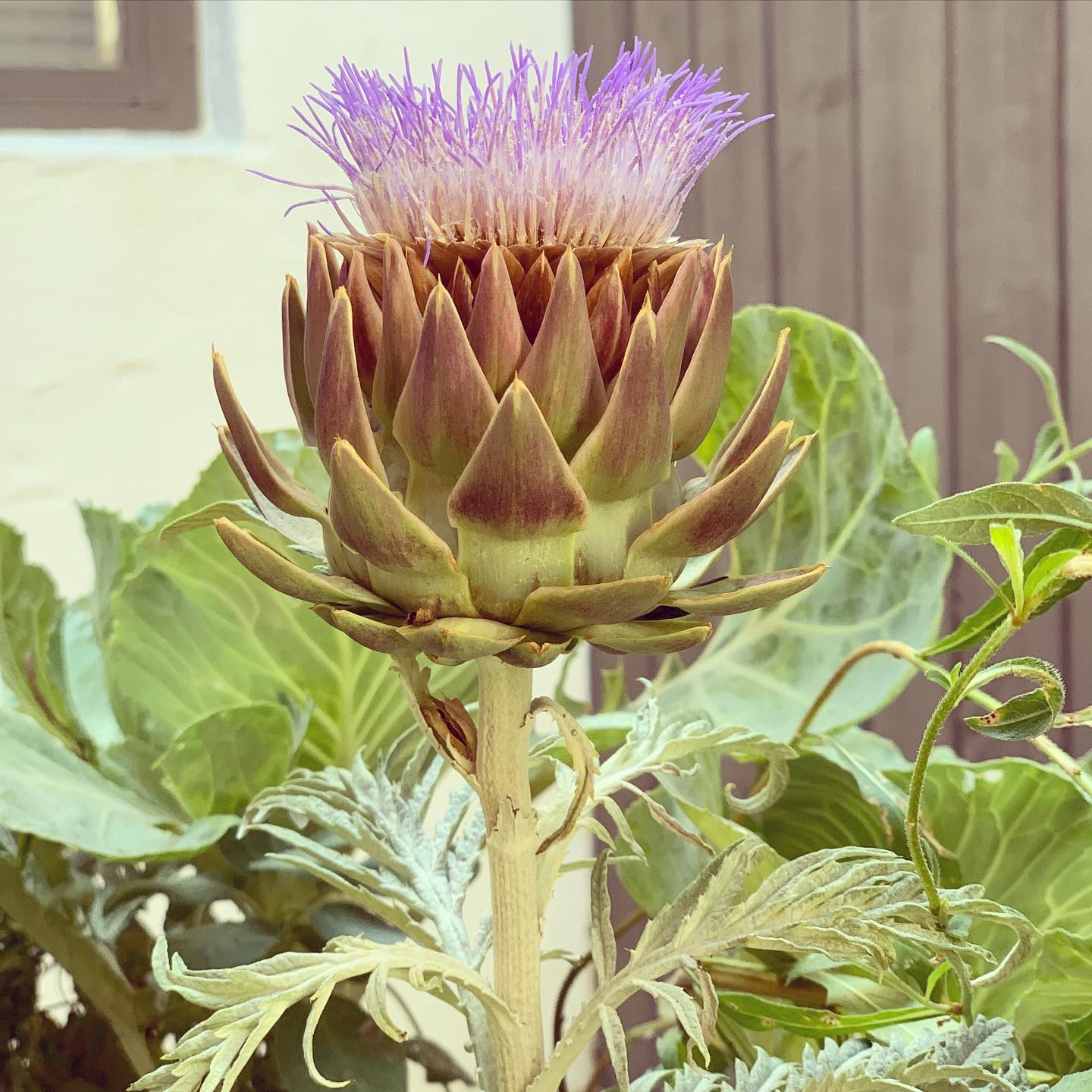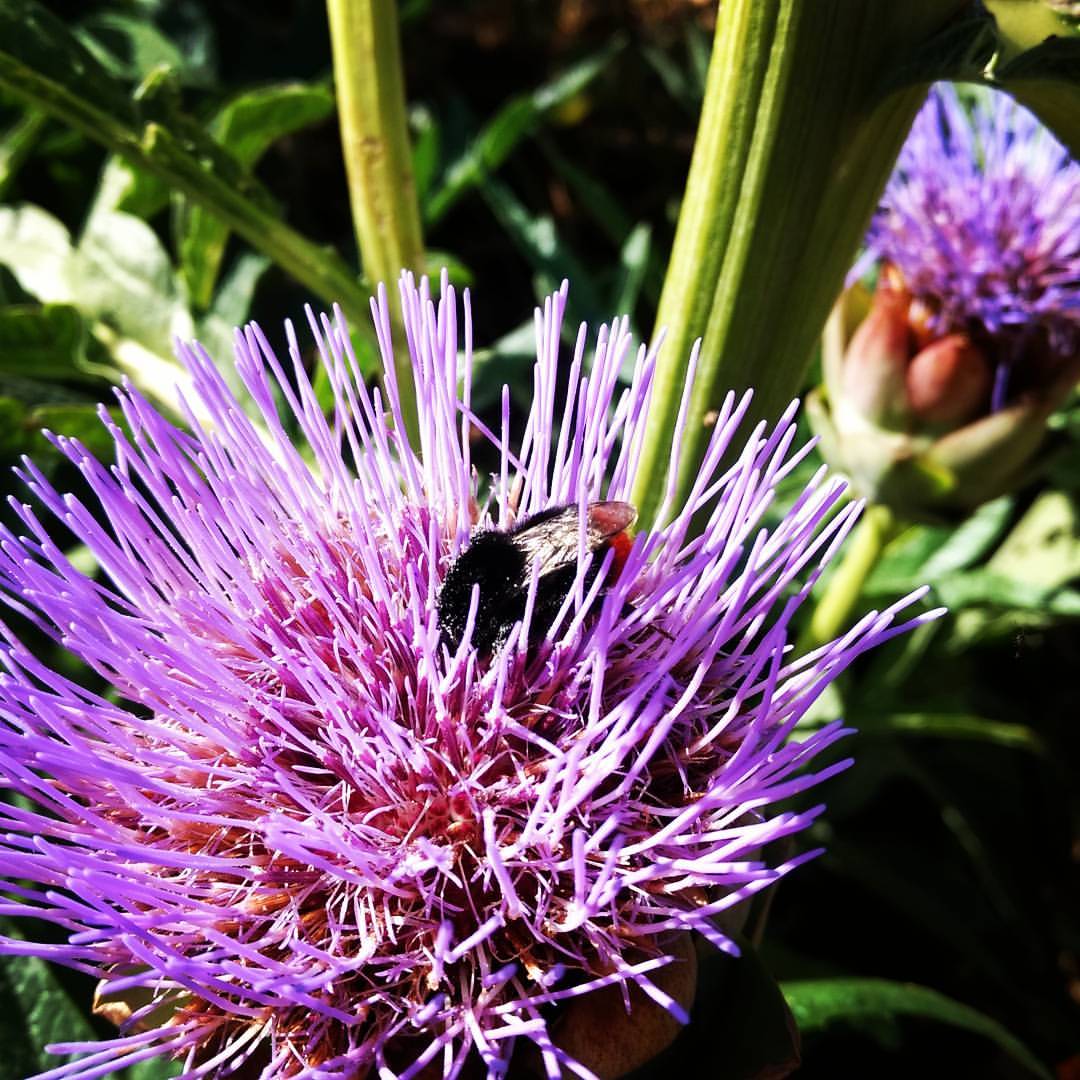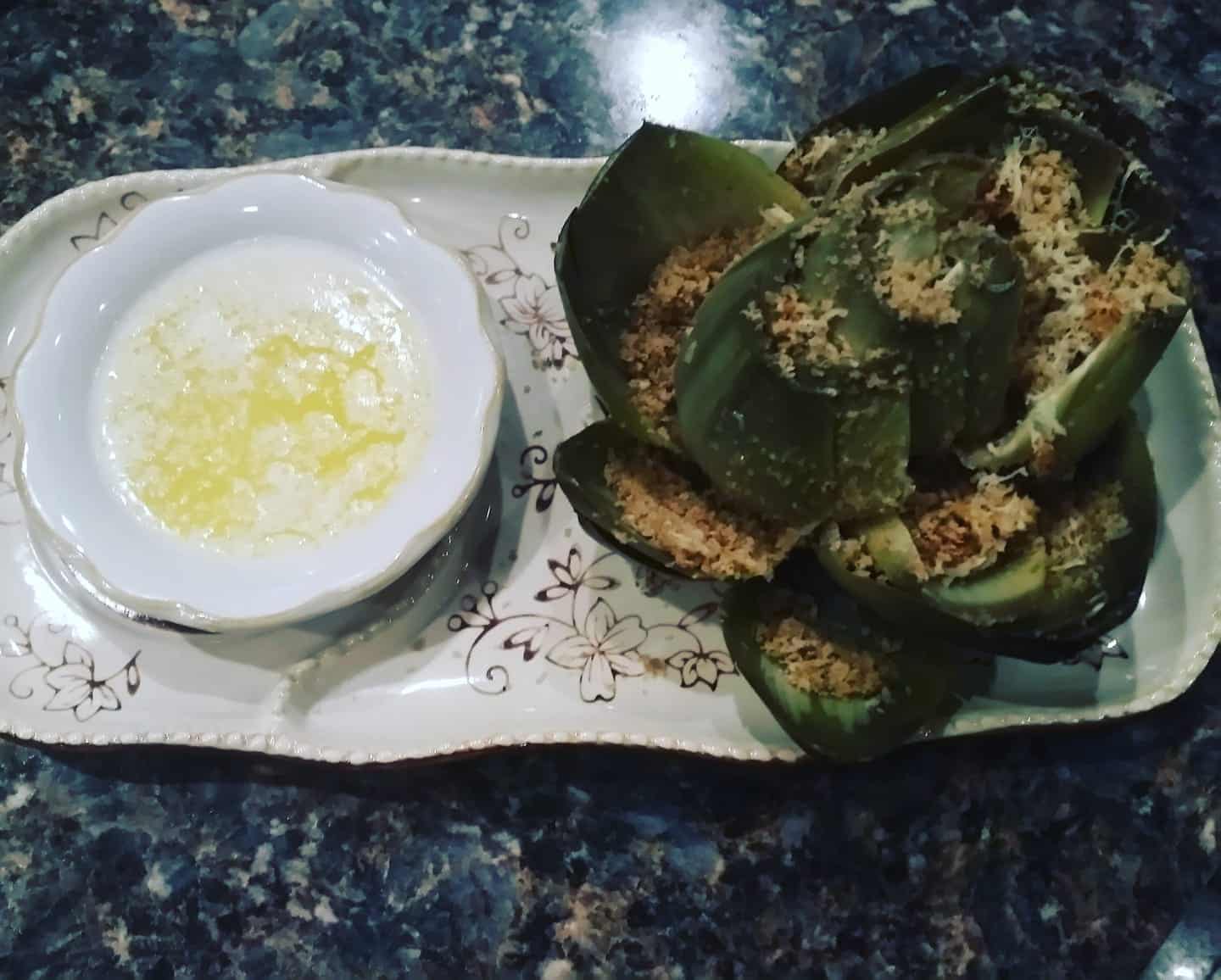Last summer, when I visited Anne, my sister, in California, I noticed her garden filled with purple blooms.
No matter what, I am always fond of flowers, so I rushed my hands to pluck them up. In the meantime, my sister called me from upstairs and showed me her album of this flower.
Generally, the Artichoke flower head is an inflorescence with numerous tiny budding flowers and bracts. The structure becomes gritty and inedible once the buds have purple blooms with a lavender center in summer.

There are more than 140 artichoke varieties, and around 40 are grown commercially worldwide.
From bouquets to food, Artichoke serves the maximum purposes of the houseplant.
If this excites you, you must have one Artichoke plant at home and here are some details on how you can start.
Let’s get behind the bloom!
Table of Contents Show
What Does an Artichoke Flower Look Like?
Artichoke flowers are easy-growing perennials belonging to the Asteraceae family, similar to Red Sunflower and Daisies. These are native to the Mediterranean region.
While many of us mistake Jerusalem Artichoke for being a variety, except for its name, it has no real connection to the Artichoke family.
Green Globe Artichoke and Big Heart Artichoke are commonly planted in the U.S., followed by Purple Italian Globe.
Generally, in 100 days, the Artichoke plant from cuttings matures into a flower, but the seed takes 110-115 days to grow into a thistle-like plant fully.
A plant can produce 6-8 Artichokes which can go as many as 10.
Let us look at the basic overview of the Artichoke flower.
| Structure | Big head, covered in bracts inflorescence with numerous tiny budding flowers and bracts |
| Size | Thistle-like blooms can grow up to 6 inches (15 cm) in diameter |
| Color | Purple blooms with iridescent lavender blue centers |
| Fragrance | Smell ranging from fleshy, bitter, fatty, green, and earthy to slightly sweet and warm |
| Toxicity | Non-toxic to human and pets |
| Edible part | The base of the petals, the center of the stem and the entire artichoke heart |
| Blooming Season | Buds appear in early spring and full bloom throughout the summer months. |
Artichoke Flower Meaning
The flowering of an Artichoke biologically represents the initiation of its reproductive phase.
It depicts the continuation of the Artichoke’s lifecycle. However, has various interpretations of the meaning and symbolism.
Generally, the Artichoke flower witnesses the symbols of prosperity and strength, while the center of an Artichoke, known as a “heart,” represents hope for future love.
Several layers of protecting scales of an Artichoke bud drop off to reach the tender meaty center. This process represents the epitome of robustness, resilience, and obstinance.

According to Greek mythology, God Zeus romantically got attracted to a woman named Cynara, who didn’t bother about the fact that Zeus was king of all gods.
Zeus, completely in awe, transmogrified Cynara into an eternal goddess.
Both willingly started living on a mountain away from the rest of the world, but soon, Cynara snuck off, longing for her home.
Infuriated, Zeus struck Cynara off the mountain, and she turned into an Artichoke as she touched the ground.
Besides, the scientific name of Artichoke (Cynara scolymus) is believed to be a tribute to the same woman.
How to Grow an Artichoke Flower?
Artichokes are grown outdoors year-round. When unplucked, it flowers into 6-inch purple bloom and looks incredible.
They are not commonly grown indoors because they require full to partial sunlight.
It is necessary to decide the proper area for planting an Artichoke for more extended benefits.
Growing an Artichoke is anything but exasperating. Here is what my sister has been using for years to grow them successfully.
| Required Tools | Specifications |
|---|---|
| Artichoke Seeds | For growing a new plant. |
| Gardening Gloves | To protect your hands from dirty and other nasty stuff |
| Seedling Tray | To plant and raise seedlings |
| Seed Starting Mix | To boost the seed germination |
| Water Can | To control watering and balance supply |
| Isopropyl Alcohol | For disinfecting the tools |
| Pruner | For clipping the flowers |
| Paper Bag | To store dry seeds |
1. Planting the Artichoke
Interestingly, Artichokes do not germinate true (identical to the parent) to the seed. They are best grown from dormant roots or rooting shoots.
Depending on the climate of a region, you can plant Artichoke cuttings in spring when grown as annuals and as perennials in a warmer zone. Besides, seeds are sown in late summer or transplanted mid-autumn.
Before planting, sow the seed indoors in the period from late February until early March. You can also directly sow the seeds in the garden from April to May.
Although planted at different times, you can follow a similar plantation process as mentioned below.
- Soak an ample number of seeds in some warm water for easy germination.
- Take a seedling tray and fill it with some seed-starting substrate.
- Place seeds individually in the soil at 1/4 inch. You can also use individual pots about 9 cm deep.
- Use a plastic sheet to cover the tray for warm and humid conditions.
- Place the tray under indirect sunlight, and spray some water twice daily.

- Transplant the seedlings once they reach 2-3 inches and beget 2-3 sets of true leaves.
- Plant the seedling 4-5 feet apart in a loamy, nutrient-rich area with proper sunlight and shade.
- Consider planting seedlings in well-drained and slightly sandy soil.
- Maintain the soil on the alkaline side (pH 6.5-7) and make sure to keep the soil moist throughout.
Sniff off the roots of at least 8 inches long offshoots from matured Artichoke, plant in the well-draining soil and place the pot in a sunny place.
2. Pollination of Artichoke
Artichoke is monecious, meaning it has a male and female part in the same plant. Luckily, both flower matures at the same time.
However, insects (honey bee, bumble bee, etc.) and vectors are crucial for transferring pollens from the anther of a flower to the stigma of another flower.
Pollinators swarm the vibrant flower for its nectar, agitating the flower that moves the pollens. Pollen reaches the stigma that further fertilizes and produces seed after 80-100 days.

The female flower has inward-pointing rounded bracts, but the male has straight-pointed bracts.
No Hand Involvement! Artichokes are self-fertile so hand pollination is not required.
3. Harvesting Artichoke Flowers
Growing Artichokes as a lovely house plant rather than an edible vegetable is out of the ordinary.
Peppy color and tall standing inflorescence add to the aesthetics of a garden.
Artichoke flowers are ready to harvest after a plant grows one year old. Meanwhile, you can enjoy Artichoke bulbs from about 180 days of planting.
After which, you can expect the purple bundle’s arrival once the bud starts opening in summer (May).
The inner core turns lavender-colored, followed by the outer flowers blooming mauve.
But wait, first, you need to harvest them properly.

- Take a sharp knife and cut the flower 2-3 inches below the stalk.
- A single plant can produce 4-5 flower heads. Be careful; leaving the flower unplucked could result in seed formation.
- The flowers could be a fresh decoration, but you must dry them for storage.
- Dry the flower under indirect sunlight and store them in a moisture-free cabinet.
If you are looking for seeds, let some Artichoke heads mature and dry without plucking them. Depending on their size, it takes one to two weeks for the flowers to dry.
The matured flowers contain seeds that can be used later if you store them after removing as much moisture as possible.
Artichoke Flower Benefits
Even if you forget to harvest Artichoke early, it still benefits you.
By now, you might be intrigued to get an artichoke plant. Knowing its benefits would strengthen your decision to grow it.
1. Floral Decoration
While most people use Artichoke as food, it blooms into a magnificent purple flower when not harvested on time.
The Artichoke flower, when not detached, opens up into intriguing petals, making a dramatic display in the garden.
Generally, Artichokes, as cut flowers or even dried, give exciting texture and color to bouquets and floral arrangements.
When dried, the thistle retains its beauty for months. Cut the flowers off using a hand pruner and suspend the flower head upside down using a string until the flower completely dries.

Adding a bunch of Artichoke flowers as tabletop decor can spice up a dull room.
Use the flowers as a statement centerpiece of a room or place at the welcoming entrance. Artichoke flowers can boost the atmosphere!
I always add Artichoke flowers to my festival decoration, such as Christmas, New York, and Thanksgiving. You can as wrap it for a bouquet!
Tips to Make DIY Artichoke Bouquet
- Hand-pick two to three Artichoke flower heads along with short stems having few leaves.
- Take a pair of scissors, cut the longer end and arrange the flowers together.
- Use floral tape to hold the flowers together.
- Add a bouquet of paper around the flower arrangement, and secure it with some tape.
- Lastly, wrap a beautiful ribbon to make it more attractive.
- Your Artichoke bouquet is ready to offer.
Gifting a bouquet of hand-picked Artichoke flowers could perhaps romantically sway your angry partner. Thank me later for the idea.
2. Flowers Attracts Pollinator
Pollination leads to reproduction and seed formation.
According to an article from the University of Catania, Italy, when in bloom, the large purple thistle-like flower of the Artichoke attracts honey bees, bumbles bees and native bees.

The Artichoke flower has a glow-like effect at dusk owing to how vivid the purple center is, enticing the pollinators.
These pollinators throng the Artichoke flower aiding further pollination.
3. Non-toxic to Humans and Pets
Artichokes are widely consumed around the globe for their unique taste and health benefits, especially in Europe.
Their popularity could prove that Artichokes are non-toxic to humans and pets.
According to Acta Horticulture, the extract from an Artichoke head are non-toxic antioxidants used in food industries, preserving and stabilizing the freshness, flavor and nutritional value.
However, people allergic to other flowers might experience the same with Artichoke flowers.
For any mishappening, contact the following hotlines.
4. Plant-Based Coagulant
Artichoke extract is a plant-based alternative to animal rennet in the cheese industry.
Impressively it coagulates the milk similar to how a regular rennet does.
As per an article by Universitat Autonoma de Barcelona, the Artichoke flower extracts used as a rennet to produce Gouda-type cheese witness similarity in yield compared to animal rennet.

The results indicate that Artichoke flower extract is suitable for replacing animal rennet in producing Gouda-type cheeses.
Rennet is a complex set of enzymes responsible for milk coagulation by separating solid curd and liquid whey.
5. Culinary Uses
Once the bud starts to open, the Artichoke becomes fibrous, woody, and tough to eat. It’s visibly uninviting.
Thus, rather than harvesting Artichokes late, it is better to let the Artichoke flourish into vibrant flowers as a charmer in the garden.
Harvest the bud before blooming, when they are tightly packed and enjoy the flavors.
Here is how I prepare my simple, flavourful Artichoke recipe.
- Boil an artichoke bud until it the outer bracts, and inner heart softens.
- Peel and separate the bract individually on a plate.

- Lightly season the separated parts with salt and pepper
- Squeeze some lemon juice on top.
- Serve it on a container of your choice, along with some melted butter, for an intense flavor.
Conclusion
Artichoke, as food and flower, is equally dazzling and a fully bloomed Artichoke flower with a purple hue is simply spellbinding.
Whether you devour the flavorsome bud or use the flower as a decoration or gift, Artichoke as a whole fits your choice.
Thus, without further reiteration, allow this periwinkle beauty to be a part of your garden.
If you want to add flowering plant, check if Bird of Paradise Flower can satisfy your need!
Happy Blooming!


